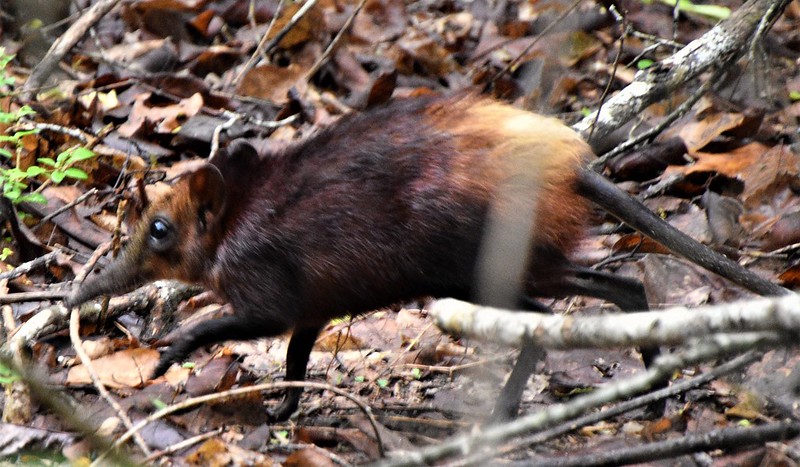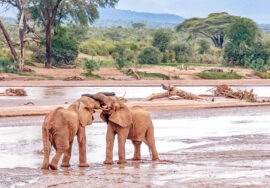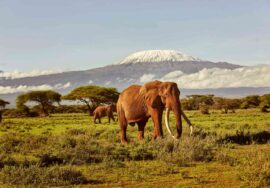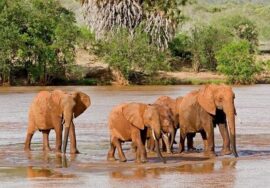
Arabuko Sokoke forest reserve
The area is a world away from the busy beach resorts even though it is only a few minutes from Watamu’s Indian Ocean beaches. Butterfly, bird, and monkey shows will happen here as they play through the forest overhead.
The Sokoke bushy-tailed mongoose and the Ader’s duiker are two other rare and threatened animals that live in this forest. The Amani sunbird, the Clarke’s weaver, and the Sokoke scops owl—Africa’s tiniest owl—make this forest glade even more beautiful.
But this reserve doesn’t just have small animals. You might also see the resident group of full-size elephants as they walk to the nearby Sabaki river, which runs along the edge of the forest. There are also deer in these beautiful woods.
For people who like to be close to nature, Arabuko Sokoke is a great place to walk. There are well-marked paths, a 4 km (2.5 mi) nature trail, and knowledgeable local guides who will show you rare animals like the golden-rumped elephant shrew.
There are several pools spread out in the forest. The Kararacha Pool is full of birds and animals, and the Whistling Duck Pool is a favorite spot for open-billed storks, grebes, and yes, whistling ducks.
Two tree platforms that people can climb up are great places to see the elephants and the dark forest below. The Nyari Cliff is another dramatic spot to look out over the lake. As soon as you get to this spot, the ground drops 80 m (260 ft), and you can see the ocean and the forest in awe.
The Arabuko Sokoke knows a lot about nature and some things about people. In this thick forest, there was a Swahili town called Gedi in the 1300s. For hundreds of years, the town did well because it was hidden from the Portuguese, who invaded and ruled parts of the African coast. The ruins of the abandoned town can still be seen through the dense wild plants.
About the Arabuko Sokoke Forest Reserve
The reserve covers 420 square kilometers (162 square miles) of coastal forest, which is East Africa’s biggest coastal forest area.
Arabicuko Sokoke is 110 km (68 m) north of Mombasa City. It is in the middle of the land between the coastal towns of Kilifi and Malinda.
When to Go: You can visit the park whenever you want because it’s open all year.
The weather is hot and dry most of the year, but it rains two times a year, from April to June (long rains) and from November to December (short rains).
The wildlife is most busy in the early morning or late afternoon, when people can see them coming out of their dens and burrows to escape the heat of the day.
Time Frame: The park is open every day from 6:00 am to 18:00 pm.
The best way to get there is by car. From the beach villas, you can book a tour with African Safari Kenya. The reserve can be found from the road that goes from Mombasa to Malindi.
To get there by air, you can take either regular or private trips to Malindi and Mombasa.
birds in the jungle crossing a path of ruins A pair of Sokoke scops owls Arabuko Sokoke Park hangs over the water at Arabuko Elephant rat, black and red
Things to see and do
Walk in the woods
Forests with a cover of trees make great places to hike and go on guided nature walks. Like we already said, you can hire trained guides to get a more in-depth look at the area.
Seeing birds
The Sokoke pipit and the spotted ground thrush are two of the over 270 kinds of birds that live here.
Milda Creek
Greater flamingos, sandpipers, and crab-plovers like to come to this pretty cove near the entrance. Walk along the pier and use the bird hide to get closer to these birds of prey.
Camping
In the reserve, there are three great places to camp: at the official spot, on the high tree platforms, or at the Nyari Cliff, where you can watch the sunrise.
Cycling and having a picnic
The forest is a great place for a picnic or a bike ride because it has lots of shaded areas and a calm atmosphere.
Arabuko Sokoke Reserve can be a useful place to visit for people who like to hike, are interested in nature, or want to help protect some very rare and endangered animals and birds. There are beach houses right next to this forest, which is a nice change of pace.








